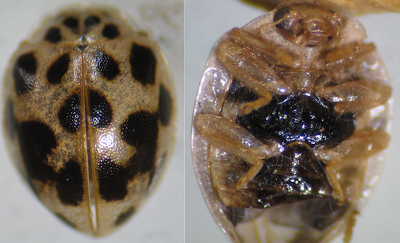Last month on a botany trip around campus, our group stopped to examine a black locust (Robinia pseudoacacia). My attention quickly wandered away from me and I found myself examining the other plants around the black locust, leading me to find some arthropods (woohoo!). One looked like an ant, but my previous experience during the summer taught me not to be too certain, so I caught it and pulled out my hand lens to take a closer look.
Imposter!
Not an ant, but rather an ant-mimic! This is actually a jumping spider (Family Salticidae), Synemosyna formica. It looks like the spider has three segments of its body like an insect, head-thorax-abdomen, but since it's a spider, it only has two: a cephalothorax and an abdomen. In order to look more like an ant, the cephalothorax is constricted, giving it the illusion of having three body segments. Now that's some fine Batesian mimicry!
Not the largest lady beetle you'll find...
It wasn't exactly the easiest insect to spot, but it was crawling around on the same leaf as the spider, so it was easy to catch both of them. Now, that picture doesn't really help you understand what this beetle looks like....sure, it's white with black spots, maybe a touch of orange, and small, but come on. A hand lens isn't going to cut it. To the dissecting microscope!
Now that's what I'm talking about!
Now we can make more sense of what it looks like. You can see the 20 spots, the texture of the shell, and what it looks like underneath. The anatomy can only tell us so much about the species, so to learn more about how it lives, let's turn to a paper published in 2009 by Sutherland and Parrella (citation can be found at the end of this post). It turns out that this lady beetle (and the others in its subfamily Halyziini) isn't predacious like most other lady beetles, nor does it eat leaves: it feeds on various mildew fungi. These are fungi in the order Erysiphales, which cause powdery mildew diseases in plants, hence their common name.
Powdery mildew disease is of economic importance in agriculture, and is the main reason why Sutherland and Parrella undertook their study. They found that P. vigintimaculata is a generalist that feeds upon a range of fungi species, and that its density in the environment increased with a greater density of mildew. That's pretty good news for an integrated pest management plan, according to their paper.
They also had a figure showing the beetle's life cycle, which follows. Note that in this study, they used a subspecies, Psyllobora vigintimaculata taedata, so that's what is being referred to.
Figure 1 from Sutherland and Parrella. (Click to enlarge)
If you see any of those crawling around on your plants, then you've got this species. Note that the adults overwinter under leaves and other secluded spaces (and warmer areas....well, as warm as you can get during winter), so you could be finding them in early Spring.
Just in case you notice some plants showing signs of mildew disease, look around for this little lady beetle. It's another way in which insects are working in our favor without asking anything in return. Isn't that great? Be sure to keep this in mind the next time you encounter multicolored Asian lady beetles seeking shelter in your home and remember: not all lady beetles are a nuisance!
Citation:
Sutherland, Andrew M.; Parrella, M. P. “Biology and Co-Occurrence of
Psyllobora vigintimaculata taedata (Coleoptera: Coccinellidae) and
Powdery Mildews in an Urban Landscape of California.” Annals of the Entomological Society of America, v. 102 issue 3, 2009, p. 484-491.


